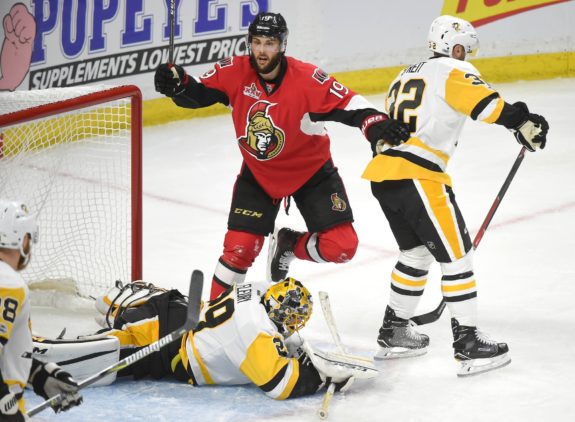The Ottawa Senators could blame a lot of things for their current six-game losing streak. Goalies Craig Anderson and Mike Condon have let in questionable goals at bad times, captain Erik Karlsson has struggled to put up the point totals he usually does, and Matt Duchene has just one goal since joining the team. However, one aspect of the team’s recent struggles has been particularly frustrating for fans—the power play.
The Senators finished last season with a 23rd-ranked power play but still managed to comfortably make the playoffs. The team continued to struggle with the man advantage in the postseason, though, with poor special teams being one of the reasons they lost in the third round.
This year, not much has changed for Ottawa’s power play. The team’s current success rate on the man advantage is 16.3%, which ranks 25th in the league. During this six-game skid, the Sens went 0-for-22 on the power play before Matt Duchene ended the drought on Saturday against the New York Islanders. The goal wasn’t just significant because it was Duchene’s first point with the team, but because the last time the Senators had scored on the power play, the same five-man unit was on the ice.
The Senators scored the game-winning goal in the second game of the NHL Global Series in Stockholm by icing their five best offensive players. The unit featured Mike Hoffman and Erik Karlsson on the points, with Derick Brassard, Mark Stone, and Matt Duchene forming a triangle in front of the net.
Spreading the Wealth
No matter who Sens coach Guy Boucher puts at forward, the team’s first power play almost always features Karlsson and Hoffman on the blueline. On the surface, this is a pretty logical combination. Karlsson is the team’s best passer, Hoffman is the team’s best shooter, and both players have enough speed to backcheck when an odd-man rush goes the other way. By putting Brassard and Stone with Duchene, the Sens have two forwards with tremendous chemistry in the middle of the offensive zone, and a proven goalscorer parked in front of the net. The Senators tried this unit twice in Sweden, with Mike Hoffman scoring nine seconds into their second shift together.
The team’s coaching staff has been reluctant to load up the top power play unit since then. Instead, Alex Burrows and Chris DiDomenico have been given some power play time to balance out the two units. While the DiDomenico experiment didn’t last very long, Burrows has been given pretty consistent power play time since he was traded to the Senators in February. Burrows has shown ability in the past to be an effective net-front player who will screen the goalie and try to score on rebounds, making him a good fit in theory.

The Senators have tried a few different players in this role over the last few seasons. When Alex Chiasson was acquired from Dallas in 2014, both Paul MacLean and Dave Cameron gave him ice time on the man advantage. Cameron also got Chris Neil to screen the goalie on the power play from time to time. After Guy Boucher took over the team, he tried putting defenceman Dion Phaneuf in front of the net, and Phaneuf even managed to score some goals this way.
So far this season, Burrows has been Boucher’s go-to-guy when he wants a net-front presence. At 36 years old, though, Burrows’ offensive numbers have been on the decline as he only managed to score once on the power play last season. Two of Burrows’ three goals this year have been scored on the man advantage, but his power-play skill-set is still pretty limited.
The Duchene Factor
On Saturday, Matt Duchene was given the net-front assignment during a power play late in the third period. Eight seconds into the penalty, Duchene scored on the rebound after Stone was stopped by Jaroslav Halak. While we’re dealing with a pretty small sample size when breaking down this unit’s success, there’s still a lot to like here. The Senators have struggled to create traffic in front of the other team’s net, but on this goal, Brassard, Stone, and Duchene were all within a few feet of the crease in case the puck came loose.

Having five players with this much offensive ability on the ice at the same time looks like a slam dunk, but it appears that the Sens’ coaching staff only put this group together because they were in a must-score situation. While Boucher seems to favour a balanced approach, there is still potential for a competent second power-play unit that could feature Bobby Ryan, Jean-Gabriel Pageau, Ryan Dzingel and Alex Burrows.
By putting Duchene in this net-front role, the Sens have more options on the power play than they do with Burrows. Duchene’s speed and strength on the puck make him a better fit for the first power play unit, he just might need some more practice with his new linemates.
There are many arguments for and against loading up the team’s first power-play unit but based on the Senators’ recent struggles, it’s worth giving their best offensive players some time together. In the NHL, teams live and die with their best players, so it’s time to give Ottawa’s top forwards a chance to turn things around.